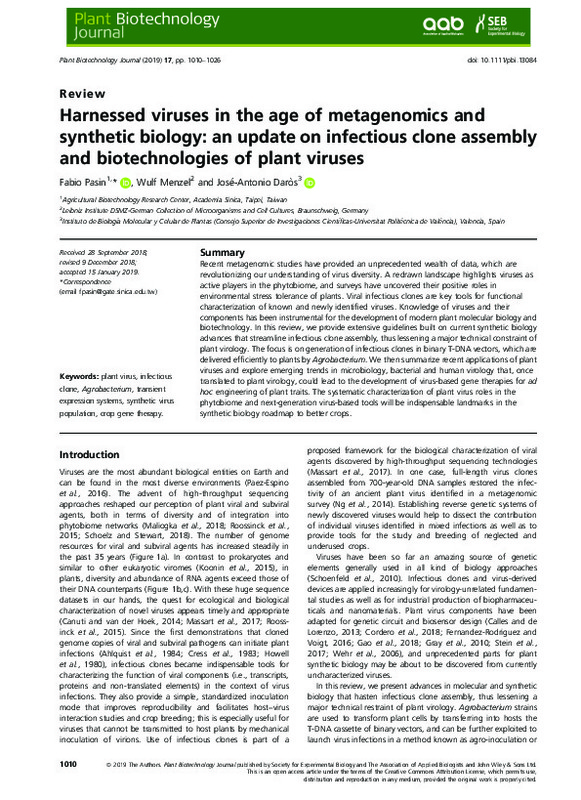Pallás Benet, V.; Garcia, J. (2011). How do plant viruses induce disease? Interactions and interference with host components. Journal of General Virology. (92):2691-2705. https://doi.org/10.1099/vir.0.034603-0
Por favor, use este identificador para citar o enlazar este ítem: http://hdl.handle.net/10251/28688
|
Título:
|
How do plant viruses induce disease? Interactions and interference with host components
|
|
Autor:
|

 Pallás Benet, Vicente
Garcia, J.A
Pallás Benet, Vicente
Garcia, J.A
|
|
Entidad UPV:
|
Universitat Politècnica de València. Instituto Universitario Mixto de Biología Molecular y Celular de Plantas - Institut Universitari Mixt de Biologia Molecular i Cel·lular de Plantes
|
|
Fecha difusión:
|
|
|
Resumen:
|
[EN] Plant viruses are biotrophic pathogens that need living tissue for their multiplication and thus, in the infection-defence equilibrium, they do not normally cause plant death. In some instances virus infection may ...[+]
[EN] Plant viruses are biotrophic pathogens that need living tissue for their multiplication and thus, in the infection-defence equilibrium, they do not normally cause plant death. In some instances virus infection may have no apparent pathological effect or may even provide a selective advantage to the host, but in many cases it causes the symptomatic phenotypes of disease. These pathological phenotypes are the result of interference and/or competition for a substantial amount of host resources, which can disrupt host physiology to cause disease. This interference/competition affects a number of genes, which seems to be greater the more severe the symptoms that they cause. Induced or repressed genes belong to a broad range of cellular processes, such as hormonal regulation, cell cycle control and endogenous transport of macromolecules, among others. In addition, recent evidence indicates the existence of interplay between plant development and antiviral defence processes, and that interference among the common points of their signalling pathways can trigger pathological manifestations. This review provides an update on the latest advances in understanding how viruses affect substantial cellular processes, and how plant antiviral defences contribute to pathological phenotypes. © 2011 SGM.
[-]
|
|
Palabras clave:
|
Virus protein
,
Cell cycle
,
Gene expression
,
Hormonal regulation
,
Macromolecule
,
Nonhuman
,
Pathogenesis
,
Phenotype
,
Plant development
,
Plant virus
,
Priority journal
,
Review
,
Signal transduction
,
Virus cell interaction
,
Cell Cycle Checkpoints
,
Host-Pathogen Interactions
,
Plant Diseases
,
Plant Viruses
,
Plants
,
Proteomics
,
Transcriptome
|
|
Derechos de uso:
|
Cerrado |
|
Fuente:
|
Journal of General Virology. (issn:
0022-1317
)
|
|
DOI:
|
10.1099/vir.0.034603-0
|
|
Editorial:
|
Society for General Microbiology
|
|
Versión del editor:
|
http://doi.org/10.1099/vir.0.034603-0
|
|
Código del Proyecto:
|
info:eu-repo/grantAgreement/MICINN//BIO2010-18541/ES/FACTORES DE LA INTERACCION PLANTA-VIRUS RELEVANTES PARA EL CONTROL DEL VIRUS DE LA SHARKA Y PARA SU USO COMO HERRAMIENTA BIOTECNOLOGICA/
info:eu-repo/grantAgreement/EC/FP7/204429/EU/Sharka Containment/
info:eu-repo/grantAgreement/MICINN//BIO2008-03528/ES/INTERACCIONES PATOGENO-HUESPED EN EL TRANSPORTE CELULAR Y VASCULAR DE VIRUS DE INTERES AGRONOMICO/
|
|
Agradecimientos:
|
We would like to apologize to those people whose relevant publications could not be cited because of space constraints. Work in the
laboratories of Juan Antonio Garcı´a and Vicente Pallas were supported by grants from the ...[+]
We would like to apologize to those people whose relevant publications could not be cited because of space constraints. Work in the
laboratories of Juan Antonio Garcı´a and Vicente Pallas were supported by grants from the Spanish MICINN (BIO2010-18541)
and the EU (KBBE-204429), and from the Spanish MICINN (BIO08- 03528), respectively
[-]
|
|
Tipo:
|
Artículo
|






![[Cerrado]](/themes/UPV/images/candado.png)




